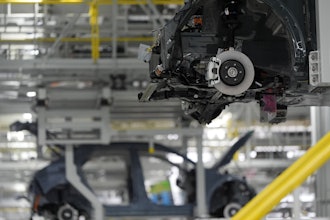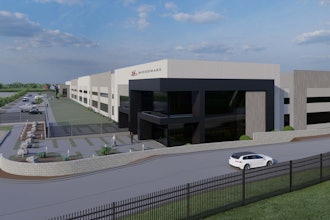No matter what the industry, weighing accuracy equals money — real money. Operating a plant with tanks and vessels that don't weigh properly costs lost time and plant efficiency. Here's a look at the critical benefits load cells can offer
By Ryan Titmas
Why have so many plants switched from the higher accuracy load cell to level probes and site glasses to determine the contents of tanks? Let's explore the most common reasons and, in the process, examine the root causes of many vessel weighing dilemmas. Keep in mind that improper specification of load cell systems is not due to incompetence by the engineer but rather lack of education on load cell weighing systems and how real-life factors can affect these installations.
Shear Beam Load Cells

Frequently overlooked during installation are the vessel's peripheral connections such as pipes, mixers, ladders, and walkways.
Shear beam load cells, known simply as load cells, are general force sensors. They cannot discriminate against true vertical load and side/torque loading. The purpose of a load cell system is to capture the true vertical load or weight within the tank; however, real-world conditions or improper installation can cause load cells to see much more than vertical loading. These factors are what causes unrepeatability in weighing and ultimately lead to load systems being dismantled. Before learning about the factors that cause inaccurate tank weighing, it's important to learn how a shear beam actually works.
A shear beam load cell is basically a precision milled piece of stainless steel that has electronic sensors called strain gages adhered to it. The strain gage is positioned at a 45-degree angle to measure the steel shear strain. Strain gages are strip conductors etched from thin metal film. They use the effect of the change that the electrical resistance of a conductor will undergo when it's subjected to mechanical stress. The change in resistance is caused by a change in length and cross-section.
The body of the load cell is typically constructed of a mild steel, stainless steel alloy, or aluminum. A typical load cell will undergo thousands of weighing cycles; as a result, the composition of the metal is critical to producing reproducible weighing results. Because a shear beam load cell is actually measuring the shear strain of the steel that occurs, errors in weighing or even load cell failures will occur if the steel is not monolithic throughout. In general, it's vital for load cell manufacturers to obtain steel and aluminum of special grade to produce the best weighing results.
Just the Facts About Tank Weighing Here are key points to consider when dealing with a tank weighing systems:• Vessel weighing applications must have a rigid support system: adequate cross bracing, a stiff foundation, and rigid legs. • The tank must be isolated. In other words, pipes entering and exiting the tank must have flexible connections, and support structures should not be "hard" connected to external structures. Also, mixers should be part of the weighing system. • Compression-type load cells should be used. • Proper mounting kits should be installed to provide protection against unwanted side forces, thermal tank expansion, and tank liftoff. • It's always best to consult with an expert in the field of weighing about your specific tank application. |
Vessel Weighing
Bending beam and shear beam load cells are the industry standard for bench and floor scales. If you lift up the pan and look underneath a scale, chances are you will find some type of bending beam load cell. If these load cells are used in bench scales, then why can't they be used in vessel weighing tasks?
Scales and balances are self-contained units that rarely encounter the extraneous side forces and environmental influences that vessels do. It's true that scales are subject to environmental factors but not to the extent of process vessels. Bending beam load cells are perfect for environments where typical static weighing takes place with a well-defined force introduction, such as in properly designed scales, but are highly susceptible to non-perfect loading. They're not intended for process vessel applications. Vessel weighing applications require a load cell and mechanical support system that can eliminate non-vertical loading, show high tolerance against non-perfect loading, and produce reproducible weighing results.
Fixing the Problem
A vessel or tank weighing application will never be successful if the actual tank construction is not adequate. What is adequate? When vessels are designed, they are designed to hold product adequately and safely while withstanding wind, earthquakes, and other forces of nature. The idea that the vessel needs to weigh accurately is generally an afterthought in the design of the tank. To help designers decide if the design of the support structure and vessel is adequate, weighing experts have come up with the double-frame principle. These frames mechanically connect the support points above and below all load cells under the vessel and ensure that they cannot move in different directions independently of each other. Since load cells only transfer vertical compression forces, the design has to ensure that they can't be tilted by external forces. Of course, separate frames do not have to be designed; the floor can be solid enough to act as a frame for load cells, and the vessel itself can be rigid enough to connect all support lugs and brackets.
Remember that the weight of the vessel is being transferred to the load cells and then to the bottom frame. Therefore, it's critical that the transfer of force be carried out with minimal deflection. The load cells can be mounted directly to the floor without the bottom frame; however, the construction of the floor must allow little deflection and settling. Because load cells are measuring deflection down to thousands of a millimeter, you are not going to achieve acceptable accuracy if your foundation deflects.
Another design problem typically found in tank weighing applications involves load cells installed at the end of long tank legs. This type of installation causes weighing errors because the individual legs move in different directions. Repeatability problems are due to the variability of movement and drift concerns caused by extraneous deflection. A better load cell installation keeps the legs from the tank shorter to minimize separate leg movement and gives the load cell top and bottom frames to help induce a more uniform loading pattern.
A frequently overlooked factor during installation is the vessel's peripheral connections and accessories, such as pipes, mixers, ladders, and walkways. Each of these external fixtures carries a specific influence on the weighing system. Pipes entering and exiting a vessel exert forces on the vessel and create no real problem under stable ambient conditions, e.g. constant temperature. But, industrial applications are far from stable, and thus pipe expansion and movement occur and can affect weighing results adversely. A simple way to dampen the effects of pipes on weighing measurements is to have all pipe connections enter from the side. Pipe hangers should be placed as far away from the tank as possible to allow for flexing as the tank moves up and down during loading. Flexible pipe connections and bellows can also be used to connect hard pipe to the vessel; however, you should make sure the flexible connections are truly flexible. Using a one-inch flex joint on a four-inch pipe probably isn't going to work. In addition, introducing a bend in the pipe — instead of a straight piece — can reduce the adverse influences of pipes and connections by a factor of 100.
Compression Load Cells
Once you make sure your tank is constructed properly and all pipe connections are flexible, the next step is to utilize compression-type load cells instead of beams. Compression load cells, unlike shear beam or bending beam, don't allow non-vertical load introductions. By using a spherical top and bottom design, properly constructed compression load cells simply cannot accept non-vertical loading. The rounded top and bottom allow the cells to right themselves during side loading by a principle of restoring forces. Compression cells are designed to shift during vessel expansion and are constrained by mechanical design to eliminate other non-vertical force influences.
Also, compression load cell are not bolted to the floor or to sub-framing as are typical shear beam load cells. All external forces, including mixers and heat expansion, cannot be avoided when using beam-type load cells. These nasty forces can be eliminated with proper compression cell mounting solutions due to both the load cell design and mechanical restraining.
Although mechanical restraints are simple devices, they take care of most complex side loading influences when used properly. Constraining devices are generally installed on the sides of the load cell mounting kits and are similar in many ways to classic turnbuckle assemblies. The mounting of turnbuckle assemblies absorb non-vertical forces from direct side loading (wind influence, etc.) and torque forces created from vertically mounted mixers. Mounting kits only perform properly if they are installed in rigid vessels, but they also must be aligned properly to absorb side forces.
Thermal Expansion
Another issue to address in tank weighing is the thermal expansion of the tank. Thermal expansion and contraction occur for a variety of reasons. The most common are jacketed heating or cooling, environmental temperature changes, and the adding of hot/cool liquids to the vessel. In these applications, where shear or bending beams are used, there is no physical way to stop the expansion of the vessel from inducing a load on the cells. The vessel wall will now be pressing outward on the load cells, creating a force vector in the downward direction, which will show as a weight change on the weighing system. This expansion will cause drastic weight changes from a few pounds or kilograms up to hundreds of kilograms. Compression load cells are not physically bolted to the floor but rather are floating and allowed to shift slightly when the tank expands. This allows for more accurate weighing during tank radius fluctuation caused by tank wall expansion.
Although blowing cool air on load cells, wrapping insulation around them, and dowsing them with water will reduce the temperature at the load cell, these actions will not stop tank expansion and thus are not adequate solutions. Installing load cells that can mechanically expand with the vessel and eliminate external side forces mechanically is the best answer.
Ryan Titmas is with Sartorius North America, 131 Heartland Blvd., Edgewood, NY 11717. He can be reached at 800-635-2906, ext. 8307, or [email protected]. Sartorius is an internationally leading laboratory and process equipment provider focusing on biotechnology and mechatronics. More information is available at www.sartorius.com.


















